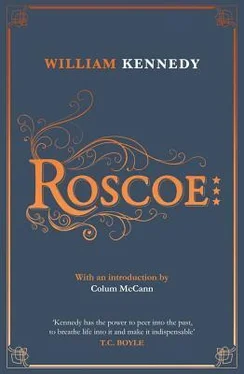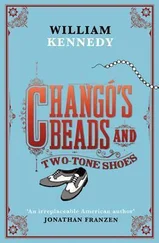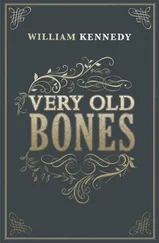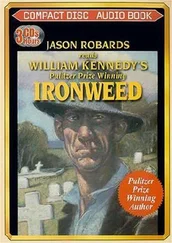Judge Finn shook his head and said, “Let’s not waste the court’s time here, Mr. Gorman, Mr. Conway. The way to resolve this is through sworn testimony, and we must hear from the infant.”
“Then we request that testimony be taken in chambers,” said Roscoe, “to make the environment less frightening for the boy.”
“We will reconvene here, in my chambers, two weeks from today,” the judge said.
To Roscoe, Veronica had been a savvy childhood goddess, creature of heavenly body to which he had modest privilege; but then she became, oh yes, high priestess of betrayal and venal dreams, human after all. Pamela was Veronica manquée, savvy and single-minded, the vulvaceous creature of devilish body and venturesome sin. Roscoe loved the blood that flowed in the young sisters’ bodies, loved their vitality and, of course, their beauty. That both were beautiful no one disagreed. When Veronica was nineteen and about to marry Elisha, she was photographed in a white parlor of her home, wearing a white, off-the-shoulder evening dress with no trace of vulgarity in her bare shoulders, standing in a smoky light that obscured her right hand and gave her an aura of ethereality. The photo was everybody’s favorite when it appeared in magazines and rotogravures, and so Pamela, at nineteen and about to marry Roscoe, had an identical photo taken to prove Veronica’s image was not a singular phenomenon, and proved the reverse. Pamela’s photo accented her shoulder bones and her curiously inelegant posture, and Roscoe concluded that, though she tried to stand upright for the portrait, her crooked soul betrayed her. Now, twenty-nine years later, here she was in court, still getting even for genetic inequities.
When he married Pamela, Roscoe had a modest income from his father’s Stanwix brewery, an enterprise that dated to 1886, when Felix bought it from John Malley, who gave up making beer in order to sell it retail in what his sons would develop into the city’s largest saloon. Two years later, Felix was elected Albany’s first mayor of Irish extraction, and the day after his election he led a parade of twelve Stanwix wagons, each drawn by a double team through the entire city, to let it be known that good things would happen to saloonkeepers who served Stanwix beer and Shamrock ale, the Democratic Party’s new official beverages. The brews remained such even after Felix was removed from office for fraud, for he continued as a figure of power in the Party, and the brewery made him a fortune. It also kept his wife, Blanche’s regal standing in the First Irish Families, that elite social unit with which Felix would have nothing to do, for, as all know, elevated social status turns the Irish into Republicans.
When the Democrats lost City Hall in 1899, Stanwix beer had a sheer falling off. But its quality kept it popular and, by 1914 its profits gave Roscoe enough income to travel comfortably in the Fitzgibbon social circle, which included the Morgan sisters. And it was these sisters, not money, or politics, that focused Roscoe’s mind. He had proposed to Veronica Morgan when he finished Albany Law School, but she married Elisha and his fortune.
Then came Pamela.
Roscoe studied Pamela the plaintiff, who remained photogenic for the newspapers, her essential blond hair durably bottled in bond. But her smile had changed: two of her incisors gone crooked. And that tantalizing body he had pressed against so often, on sleigh rides, at dances, even when pursuing Veronica, had developed into one of Pamela’s worst fears: the thickening middle. Together at Veronica’s wedding reception at the Albany Country Club, Roscoe and Pamela had watched thick-middled Honey Mills, fiftyish, hair like straw dyed black, talking with three men sitting on chairs across from her, and offering them all a prolonged revelation of her thigh. Pamela said an ugly, shapeless woman doing such a needy thing was pathetic, but then she and Roscoe went off to the shadowy cloakroom, where Pammy kissed him and gave him exploration rights. Divested of one sister, Roscoe took the other. He courted Pamela, went with her downtown, even to Fifth Avenue on the New York train, shopping for hats, coats, dresses. He kept her company when she was blue, took her to Dr. Warner’s office when she had the stomach pains, sometimes associated with her monthlies, took her to dinner at Keeler’s, to dances at the Yacht Club and the Hampton Roof Garden, and went with her on vacation to Tristano, the great Adirondack camp Lyman had started building in 1873. It was both Ariel’s and Elisha’s favored retreat. Elisha always invited Roscoe, and Roscoe always went, for Veronica would be there.
But Pamela became his primary interest during this visit to Tristano, where social fantasia pervaded the air like the scent of pine trees. Accessible from the railhead at North Creek only by horse-drawn carriage and then by steamer across the lake, Tristano was isolated amid the loons and raccoons, the foxes, eagles, and great horned owls, and surrounded by alders, spruces, cedars, white pine, and hemlocks. Its twenty-four buildings along the shoreline seemed on first approach to be the edge of a small city that extended infinitely backward into the estate’s two thousand wooded acres. And indeed it bustled like a city when family friends and servants put it to full use. Life amid this animated isolation, this log-cabin luxury of the uncommonly rich, offered the visitor a transformation of expectation. What happened here seemed a charade played out among real people by unreal rules with improbable consequences — Roscoe, for instance, alone on the floor with Pamela on two raccoon coats at four in the morning, proposing marriage, being accepted, then bringing her back here as a bride.
Their honeymoon was romantic solitude in front of open fireplaces, long walks in the pineydown woods, cool swims in the lake’s morning stillness, and pointed talk, never about tomorrow, but about how they would spend the abundance that was today. Looking at Pamela in the courtroom, Roscoe remembers that vivid yellow hair when the yellowness was real, can see her in a shimmering blue summer evening gown, then slipping effortlessly out of it, remembers how she walked or provocatively sat, and how much he loved her. But he now knows this love was independent of Pamela, a consequence of his own unruly capacity for love.
After Veronica married Elisha, Roscoe could no longer love her as before; and so loved Pamela instead, and she loved him, and they married, made love, and made love again, half a dozen times the first day. In between they ate what the Tristano servants cooked for them: fresh fish from the lake, a pheasant shot by Kendrick, Ariel’s resident woodsman. They drank lightly to keep love at a sharp edge, took the boat out on the lake to find a place where there was no sound. Their lives became elemental, centering on the forest, the water, the bed, and the belief that life was purposeful, even though its only discernible purpose was love, effortless love that Roscoe could give and receive at will. And he loved it, loved Pamela, loved that he loved her, loved women, loved love.
When they woke into the third day of the honeymoon, Pamela was revisited by her old pain. She ate sparsely and said she would not give in to it. They fished off the dock by the Trophy House, and Roscoe was reeling in a small trout when they saw the steamer coming across the lake. He threw the trout back and stowed the fishing rods in the house, and they walked to the pier to meet the invaders. Ariel was first off the steamer.
“Ah, my little ones,” he said to Roscoe and Pamela, “I didn’t expect to find anyone waiting for us.”
“We’re three days into our honeymoon,” Roscoe said.
“What a pity to disturb you.”
“But we’re disturbing you in your own house, Ariel,” Roscoe said. “Elisha did know we were coming. I’m surprised he didn’t tell you.”
Читать дальше












